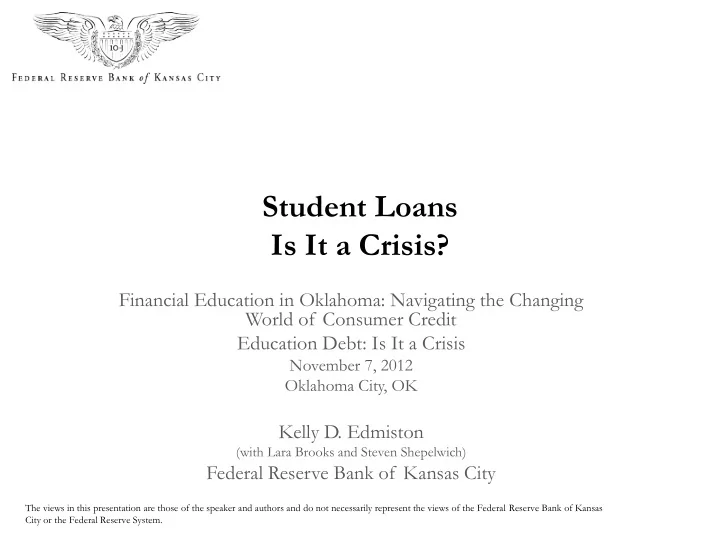

Student Loans Is It a Crisis? Financial Education in Oklahoma: Navigating the Changing World of Consumer Credit Education Debt: Is It a Crisis November 7, 2012 Oklahoma City, OK Kelly D. Edmiston (with Lara Brooks and Steven Shepelwich) Federal Reserve Bank of Kansas City The views in this presentation are those of the speaker and authors and do not necessarily represent the views of the Federal Reserve Bank of Kansas City or the Federal Reserve System.
Student Loans Overview and Issues • Growth in Student Loan Lending • Student Burden, the Capacity to Repay, and Delinquency • Fiscal Impact Paper is available at http://www.kansascityfed.org/publications/research/cap/index.cfm Presentation is available at http://www.kansascityfed.org/speeches/ K. Edmiston, FRBKC 2
Outstanding Student Loan Debt $trillions $trillions $1.0 $1.0 0.904 $0.9 $0.9 $0.8 $0.8 $0.7 $0.7 $0.6 $0.6 $0.5 $0.5 $0.4 $0.4 $0.3 $0.3 $0.2 $0.2 $0.1 $0.1 $0.0 $0.0 2003 2004 2005 2,006 2,007 2008 2009 2010 2011 2012 Source: Federal Reserve Bank of New York K. Edmiston, FRBKC 3
Growth in Student Loan Lending $2010 Billions $2010 Billions $50 $50 Unsubsidized Stafford $40 $40 Subsidized Stafford $30 $30 $20 $20 Other Federal $10 $10 Nonfederal $0 $0 2000-01 2001-02 2002-03 2003-04 2004-05 2005-06 2006-07 2007-08 2008-09 2009-10 2010-11 Source: The College Board, Trends in Student Aid K. Edmiston, FRBKC 4
Outstanding Student Loan Debt • Most of increase coming from increased number of borrowers – increases in average debt is moderate – Largely driven by enrollments – Moderate increase in share who borrow – Fairly substantial increase in average debt in past year (Equifax) • What is the issue? – Borrower capacity to repay / burden – Fiscal burden K. Edmiston, FRBKC 5
Capacity to Repay / Burden Individual Student Loan Debt Statistics (First Qtr, 2012) • Median $13,662; Average $24,218 – 25% under $5,977 – 25% over $29,155 • > 3% with debt over $100,000 • 0.5% over $200,000 • 40% of borrowers under 30 (1/3 over 40) Sources: Authors’ calculations using data from the Federal Reserve Bank of New York Consumer Credit Panel; Federal Reserve Bank of New York K. Edmiston, FRBKC 6
Capacity to Repay / Burden Credit Profile of Student Loan Borrowers Profile of Student Loan Borrower Credit Conditions, First Quarter, 2012 Student Loan Borrowers Non-Student Loan Borrowers First Third First Third Credit Item Average Median Quartile Average Median Quartile Quartile Quartile Student Loan Debt $24,218 $13,662 $5,977 $29,155 n/a n/a n/a n/a Total Debt 82,994 24,576 6,608 106,027 $66,227 $3,522 $0 $68,440 Consumer Debt /*/ 31,883 17,999 5,500 41,097 13,084 1,379 0 13,850 Revolving Debt 6,888 644 0 4,470 7,703 283 0 3,349 Credit Score 626 696 /*/ Total debt less first mortgage. Source: Authors’ calculations using data from the Federal Reserve Bank of New York Consumer Credit Panel / Equifax K. Edmiston, FRBKC 7
Student Loan Delinquency (share of outstanding loans) NY Fed: 27% delinquency in repayment Sources: Authors’ calculations using data from the Federal Reserve Bank of New York Consumer Credit Panel K. Edmiston, FRBKC 8
Issues Driving Delinquency • Recession and Recovery – Younger hit hard • Peak unemployment 17.1 percent (Apr 2010) • Underemployment • Slower wage and salary growth • AP: 50% unemployed/underemployed • Noncompletion – Better prospects for completers – Especially high for for-profit • No credit consideration • Poor borrower information K. Edmiston, FRBKC 9
Fiscal Impact • Accrual-based budgeting – NPV (incl disbursements, subsidies, payments) – Federal Credit Reform Act (FCRA, 1990) method – Federal Government Costs using FCRA • FY2011: -$47.3b • FY2012: -$34.3b (est.) • FY 2013: -$32.2b (proposed) – Updates – vs. fair-value K. Edmiston, FRBKC 10
Fiscal Impact • Accrual-based budgeting (cont) – Fair-value estimates • CBO: 11 percent of disbursements • Implies $13.3b (+$3b consolidation) • Indirect – Greater income tax revenues; lower costs – Interest deductions • Outlook – Not expected to see much higher default rates – Could see continued rapid increases in borrowing – Reform options K. Edmiston, FRBKC 11
Contact Information: Kelly D. Edmiston Senior Economist Community Development 1 Memorial Drive Kansas City, MO 64198 (816) 881-2004 Kelly.edmiston@kc.frb.org
Recommend
More recommend